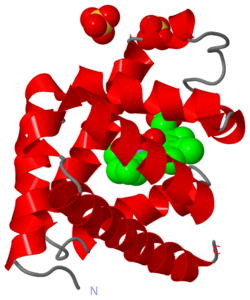JMS/sandbox22
From Proteopedia
(Difference between revisions)
| Line 2: | Line 2: | ||
<!-- <StructureSection load='1mbn' size='350' side='right' caption='myoglobin (PDB entry [[1mbn]])' scene='57/575026/Electrostatics/10'> --> | <!-- <StructureSection load='1mbn' size='350' side='right' caption='myoglobin (PDB entry [[1mbn]])' scene='57/575026/Electrostatics/10'> --> | ||
[[Image:1a6m.png|250px|left]] | [[Image:1a6m.png|250px|left]] | ||
| - | '''Extraordinary Proteins. Extreme''' lifestyles sometimes require | + | '''Extraordinary Proteins. Extreme''' lifestyles sometimes require sensing the earth's magnetic field. Trytophan and aspartic acid residues may be key to an organism's ability to pick up where it is relative to the earth's poles. |
| - | + | ||
---- | ---- | ||
| Line 9: | Line 8: | ||
---- | ---- | ||
| - | ''' | + | '''Birds''', turtles, butterflies and other animals migrate with the help of the compasses built into their bodies. Little is known about the mechanistic nature of these compasses, and to fill the gap in knowledge, researchers at the theoretical and computation biophysics group at the University of Illinois at Urbana-Champaign describe a systems based on a flavoprotein known to process light for entraining circadian cycles, but now perhaps also should be known as the seat of these organism's ability to sense magnetic fields[http://www.ks.uiuc.edu/Research/cryptochrome/]. <ref name="whaleMyo"> DOI:10.1126/science.1234192</ref>. |
---- | ---- | ||
Revision as of 19:58, 13 May 2014
| |||||||||||
References:
- ↑ Mirceta S, Signore AV, Burns JM, Cossins AR, Campbell KL, Berenbrink M. Evolution of mammalian diving capacity traced by myoglobin net surface charge. Science. 2013 Jun 14;340(6138):1234192. doi: 10.1126/science.1234192. PMID:23766330 doi:http://dx.doi.org/10.1126/science.1234192

